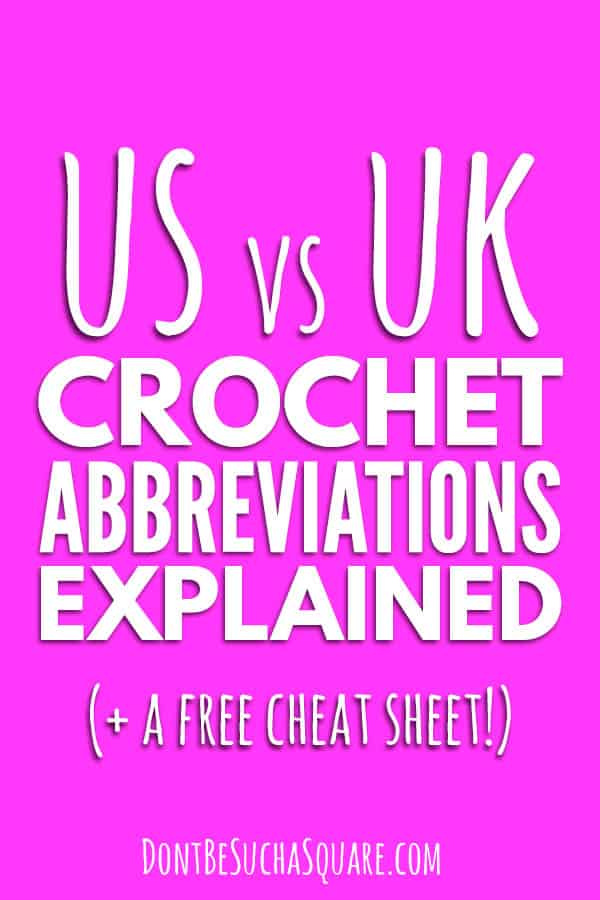US vs UK crochet terms explained
US and UK crochet abbreviations and terms differ a bit, this mean you can’t just take a pattern written in UK terms and crochet as usual if you’re used to crochet in US terms, and vice versa.
It would be great if crochet terms were standardized in the English language! Unfortunately, that’s not the case.
Patterns from British and Australian designers often use the UK terms, while American designers often use US terms. So if you’re wanting to be able to crochet them all, you need to know the differences and how to translate them!
Both terminologies use the same words (stitch names) both for different stitches, confusing I know… that’s why I’ve made us a conversion chart that you will find further down in the post!
What’s the difference between UK and US crochet terms?
The difference between US and UK crochet terms is the starting point. US terms start with single crochet while UK terms call the same stitch double crochet. the next step up is the US double crochet called treble crochet in the UK.
UK stitch names are always one step up from the US ones. This is because US terms rely on the number of yarn overs when pulling up your first loop, while the UK terms are based on the number of loops on your hook.
This is all very confusing at the beginning, but translating between the two sets of stitch names and terms isn’t that hard once you start understanding what you’re doing!

Which terms are the same?
There are two terms that are the same in both US and UK terms, chain (ch) and slip stitch (ss).
US vs UK crochet terms: Stitch comparison
This conversion table is a start for learning to translate between US and UK terms. These are the most common stitches and a couple of terms to get you started!
- Chain (ch) US – Chain (ch) UK
- Slip stitch (ss) US – Slip stitch (ss) UK
- Single crochet (sc) US – double crochet (dc) UK
- Half double crochet (hdc) US – Half treble crochet (htr) UK
- Double crochet (dc) US – Treble crochet (tr) UK
- Treble/triple crochet (tr) US – Double treble crochet (dtr) UK
- Double treble crochet (dtr) US – Triple treble crochet (trtr) UK
- Back post double crochet (bpdc) US – Raised treble crochet back (rtrb) UK
- Front post double crochet (fpdc) US – Raised treble crochet front (rtrf) UK
- Single crochet 2 together (sc2tog) US – Double crochet 2 together (dc2tog) UK
- Double crochet 2 together (dc2tog) US – Treble crochet 2 together (tr2tog) UK
- Yarn over (yo) US – Yarn over hook (yoh) UK
- Gauge US – Tension UK
How do I know if a pattern is written in US or UK terms?
The designer usually writes this out either along with the abbreviations or in the pattern description. If you don’t have this information, there are two ways to determine which type of terms is used.
- Look at the stitches in the pattern. If there’s single crochet (sc), you’re looking at a pattern using US terms (as that term doesn’t exist in UK terminology).
- Look for a half treble crochet (htr), this term only exists in UK terminology.
- If there’s a crochet diagram, compare this to the written instructions, compare the stitch names to the conversion chart below.
- Patterns using words like “tension” and “miss a stitch” are written in UK terms. If “gauge” and “skip a stitch” are used your pattern uses US terminology.
Crocheting vintage patterns
Vintage patterns are often beautiful, and sometimes a bit hard to read. Many of them are written by Brittish or Australian designers and therefore in UK terms. In some patterns it’s stated which terminology is used, in others it’s not.
If you’re uncertain use the tips I mentioned in the list above to determine if US or UK terms are used.
Australian crochet patterns
Many crochet patterns are written in Australia, both vintage and modern ones. Australian designers most commonly use UK terms in their patterns, so check your pattern to see if this is the case. You can use the tips in the list above if you need some help!
Patterns available in both US and UK terms
Nowadays many patterns designers publish their patterns in both terminologies to make it easier for us crocheters, isn’t that nice!
As we become more and more used to use the internet when searching for patterns, inspiration, and crochet friends from all over the globe the need for designers to adjust and publish patterns in both sets of terms has increased. And, of course, for crocheters to learn how to translate. This is a truly wonderful opportunity to make more fun crochet projects!
I hope these tips and the conversion table will help you crochet a wider range of patterns. And remember, you could always try to get in contact with the designer if you have questions about a pattern!